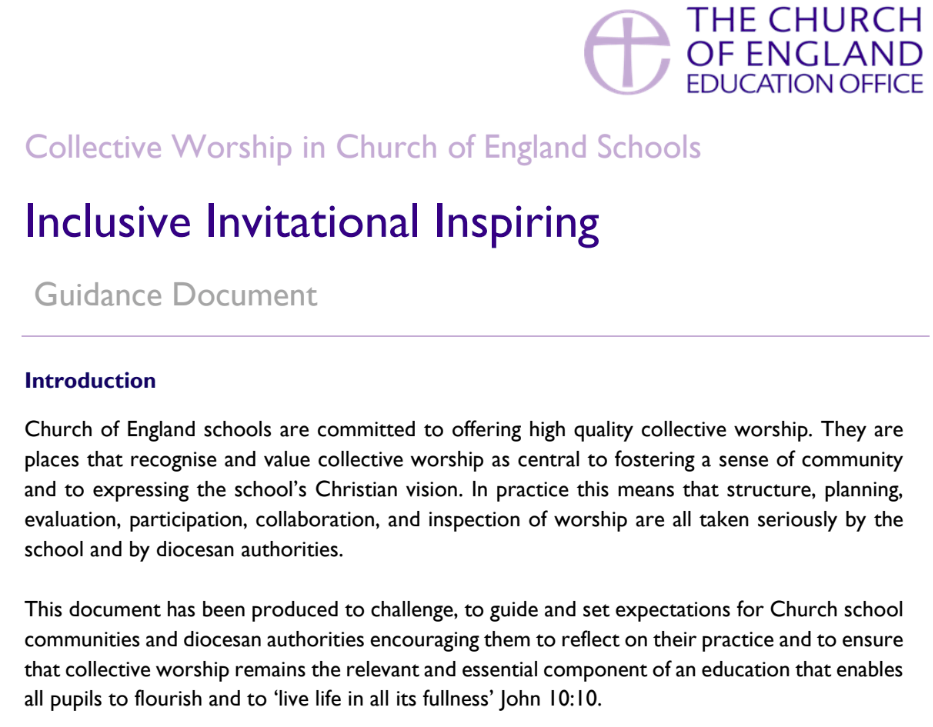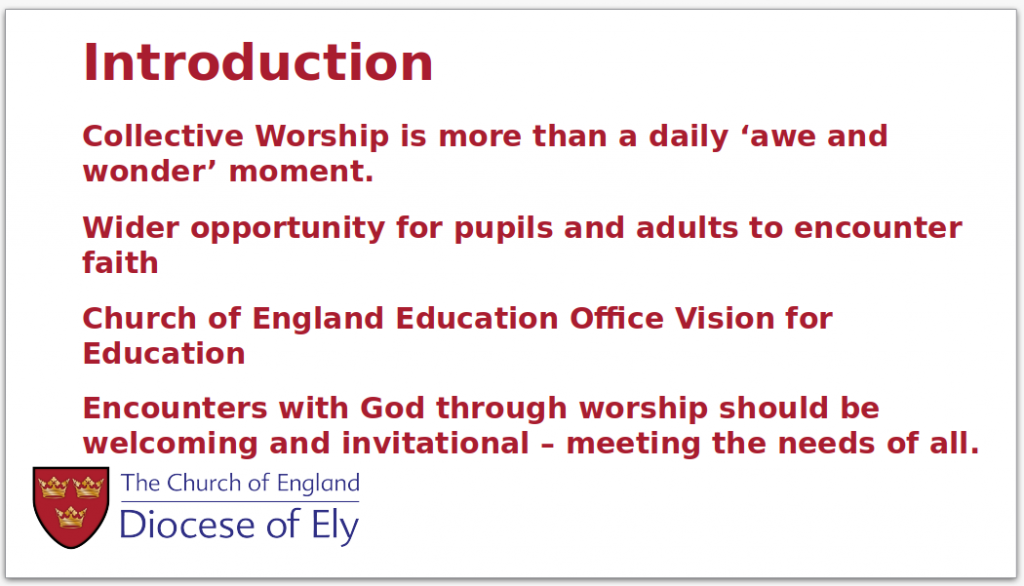In Church of England schools, collective worship helps to build a strength in the school community and to develops learners’ understanding of Anglican traditions and practice.
 Involvement with the local vicar or representative supports planning and acts of worship that are invitational, reflective, and engaging. There is flexibility in our collective worship to enable all pupils to benefit without compromising their beliefs.
Involvement with the local vicar or representative supports planning and acts of worship that are invitational, reflective, and engaging. There is flexibility in our collective worship to enable all pupils to benefit without compromising their beliefs.
Collective worship gives pupils and school staff the opportunity to:
- Engage in an act of community.
- Express praise and thanksgiving to God.
- Be still and reflect.
- Explore the big questions of life and respond to national events.
- Foster respect and deepen spiritual awareness.
- Reflect on the character of God and on the teachings of Christ.
- Affirm Christian values and attitudes.
- Share each other’s joys and challenges.
- Celebrate special times in the Christian calendar.
Diocese of Ely Collective Worship Resources
Diocese of Ely Collective Worship resources are not intended to be prescriptive, but used as a guide and adapted to suit the vision of your school or academy and the message you are trying to share.
Linked below is a 20 week Collective Worship plan created and used by our RE advisor Jemma Coulson. The plan is intended to be used as a template, adapted to suit the individual setting. As such it is not intended to be prescriptive and does not have to be followed sequentually, but is designed to give suggestions.
We have also shared a PowerPoint intended to support schools and academies regarding inspirational collective worship, as a guide to greatness. If you have any questions or would like to share your own resources or ask for help please contact jemma.coulson@elydiocese.org.
Other Collective Worship Resources can be found using the following links:
Resources available for information and planning collective worship
Collective Worship Guidance
- Download this PowerPoint document here – external link
Educational purpose of collective worship
- Download the full document here – (.pdf)
- View, print or download the full .ppt file here – external link
Other Collective Worship Resources
- Pupils monitoring collective worship Version 1 and Pupil monitoring collective worship Version 2 – these two slightly different leaflets can be filled out by pupils following an individual act of collective worship and be added to the governors’ monitoring file. Use the one which best matches your current worship monitoring priorities.
- Is your worship Blessed? Check here!
- Worshipping in Classrooms – this booklet on classroom based worship includes an appendix on worship themes for the Church Year
- Pupils as collective worship leaders
- Inviting Visitors to lead Collective Worship in Your School
- Eucharists in Schools – some Questions and some Answers
Arrangements for collective worship in a Church school are the responsibility of the foundation governors in consultation with the headteacher.
There are three main legal requirements for collective worship which it is important to observe:
- Collective worship in a church school should be carried out in accordance with the school’s founding trust deed, and in accordance with the School’s ethos statement, which is to be found in the statutory Instruments of Government. It must, therefore, be wholly Christian in nature.
- The school must provide an act of collective worship for all pupils every day.
- This act of worship can take place at any time of the school day and in any regular school grouping e.g. whole school, key stage or class unit.
A statement must be included in both the collective worship policy and the school brochure/website that makes it clear parents may withdraw their children from collective worship on religious grounds. (The ‘religious grounds’ do not have to be justified and explained by the parents) Should children be withdrawn, the school must provide adequate supervision to ensure their safety. Staff who withdraw children from collective worship (e.g. remedial reading, music lessons) are breaking the law!
Collective Worship and Assembly – are they the same thing?
It is still customary in the majority of schools for teachers and pupils alike to use the term ‘assembly’ when they are referring to the ‘act of collective worship’. This accepted shorthand should not be allowed to blind us to the differences between the two activities.
Schools frequently assemble for a common purpose. In essence the purpose of most school assemblies is to gather the school for collective worship followed by the sharing of notices. In this scenario, pupils withdrawn from collective worship should rejoin the rest of the school for the assembly notices. There are many elements which worship and assembly have in common, such as helping children to develop common standards and values, or to develop an awareness of, and a concern for, the needs of others.
However, the presence of these common elements alone does not turn an assembly into an act of collective worship. It is a mistake to assume that, for example, inviting a charity worker to address the school during the ‘collective worship slot’ is collective worship. In each and every act of collective worship some of the elements of worship (ie of ‘giving worth to God’) must be present. An Assembly may include Collective Worship. Not every Assembly is Collective Worship.
The Anglican Tradition
When planning collective worship, Church Schools should be aware of their Anglican foundation and consider how this can contribute to the assembly provision – without reproducing something inappropriate to the children’s age and experience. The following may be described as shared Christian elements of collective worship:
- Using the Bible, either as a source book, or as an inspiration for themes and stories
- Observing the cycle of the Church’s Year – Advent, Christmas, Lent, Easter, Pentecost, Saints Days
- Learning and saying traditional prayers from a number of sources, in particular the Lord’s Prayer and the Grace
- Singing a wide variety of hymns, from traditional to rap
- Using Christian symbols in worship and reflecting on their meaning
- The use of prayer, silence and reflection
- Using Psalms with simple responses
Whilst these are more distinctively Anglican:
- Using prayers from Common Worship
- Using Anglican sentences and responses e.g: The Lord is here / His Spirit is with us; Peace be with you/ and also with you; Go in peace to love and serve the Lord / In the name of Christ, Amen
- Using Collects as a focus for worship
- Eucharists
Encouraging links with the worship of the local parish church
The Anglican Church is a worldwide church with a strong commitment to ecumenism, so Church of England schools should also feel free to draw upon appropriate materials from other Christian churches in their collective worship, as well as inviting visitors from other churches to lead collective worship on occasions. Anglican worship from different cultures and traditions adds to the richness of experience.
So what actually is collective worship?
Christian worship is an honouring of God. Worship stems from personal experience; it is a central characteristic of faith communities which are in relationship with God. We can never make anyone worship because it is an attitude of the heart focused on God; in the school situation ‘all’ we can do is lead people to the threshold of worship by providing a setting where they may worship God if they so wish.
The term collective worship is used only in education, whereas churches and religions usually think of their worship as being corporate. The implication of this is that when a group of people gather together due to shared beliefs with the intention of sharing worship then this is a corporate activity. No such assumptions about shared beliefs can be made in the case of a school community, even a church school. The school is a collection of people who come from a variety of backgrounds and who happen to be together primarily for the purpose of education, not for worship. The family backgrounds of pupils may be very different in terms of beliefs and adherence to religion. Where parents have choice about which school their child attends, this is often limited by geographical factors and the church school still cannot claim the right to use school collective worship as an act of corporate worship.
What takes place in collective worship must take account of the varied backgrounds of the pupils (and staff) as well as of their ages and aptitudes. In collective worship children and adults will be responding to the worship on offer in different ways and at different levels; it is the task of collective worship to provide a setting in which the integrity of those present is not compromised but in which everyone finds something positive for themselves. Collective worship plays a central role in a Church School; it models the school’s Christian ethos and values, and proclaims its Church School identity. As a result it should:
- Have a recognised place in key school documents such as the Statement of Aims or Statement of Purpose
- Be well organised, planned, delivered and resourced
- Have a place in the development and improvement cycle
- Be special and different from ordinary classroom activities, offering a sense of occasion
- Be both inclusive and unifying, recognising the personal integrity of all members of the school community
- Be real worship, thus offering the possibility that those who choose to worship in this situation may be enabled to do so.
The Aims of Collective Worship
It is important to ask how the worship is related to the school’s Mission Statement or Statement of Purpose. Worship in church schools should be of the highest quality and a central activity in the life of the school. Effective collective worship is one way in which a Church School can give expression to its founding trust deed. Below are some of the accepted aims of collective worship in a Church School:
- To help children discover their place in the world.
- To provide an opportunity for the children to reflect upon God and to give Him honour
- To highlight and nurture the spiritual dimension through experiencing worship.
- To provide children with a vocabulary of worship and an experience of a wide variety of worship forms, including symbols and imagery.
- To provide an opportunity to celebrate Christian festivals.
- To heighten awareness of the ultimate questions / realities of life and to provide the opportunity to reflect upon these.
- To support the search for meaning.
- To enable children to appreciate their worth and value to God, and to the community, and to respect the integrity of each individual as a child of God
- To enable pupils to make effective use of silence in opportunities for reflection, contemplation, meditation and prayer.
- To celebrate gifts, talents and achievements.
- To establish, explore, and reinforce the common Christian values of the school community such as love, peace, kindness, compassion.
- To foster a feeling of community and belonging in the school through a sharing of experiences and feelings.
- To develop personal relationships and to encourage social development.
- To provide an opportunity to empathise with the needs of others.
- To provide an opportunity for children to become acquainted with people from the local and wider community, particularly the local church.
- To encourage respect and care for God’s creation by a positive attitude to both local and global environmental issues.
- To foster feelings such as awe, wonder, thankfulness, mystery and joy.
- To give memorable and enjoyable experiences.
- To provide an opportunity to bring personal needs and those of others before God in prayer.
- To share with participants some of the central teachings of the Christian faith at an appropriate level and thereby give them the encouragement to explore their own beliefs and understanding of God within a Christian framework.
We recommend that Church Schools use a four part model of worship in their collective worship, with liturgical greetings and the format “Gathering, Engaging, Responding, Sending” (GERS) which is the outline format for any Church of England Service of the Word. Flippin’ Praise is an excellent resource with which to do this and can be purchased through ChurchschoolsEast. The principles are applicable to whole school, key stage and class worship. The notes below are to help with your preparation using this format.
Gathering
- We gather together and greet each other.
- We all come to play a part in this community.
- We are preparing to meet God.
- How is the room set up?
- How is seating arranged?
- Does everyone know what they should be doing?
- What will the greeting be like?
Engaging
- We engage with the big things and the little things in life.
- We encounter Jesus and the stories of the Bible.
- We are listening for God’s message for us.
- How will you share God’s message?
- How will you share your own experiences or contemporary events?
- What strategies will you use?
Responding
- We respond to what we have heard and seen.
- We respond together as individuals.
- We are given the opportunity to worship God.
- Will you use singing or prayer or reflection time?
- Will there be a practical response and how will this be encouraged?
- Do you give enough time to responding?
Sending
- We are sent out to love and serve one another and to make a difference in the world.
- We are all dismissed with God’s blessing.
- How will people leave worship – singing? silently?
- Will there be special words of blessing or dismissal?
Faith Image: Pixabay, Creative Commons – Pexels.com



